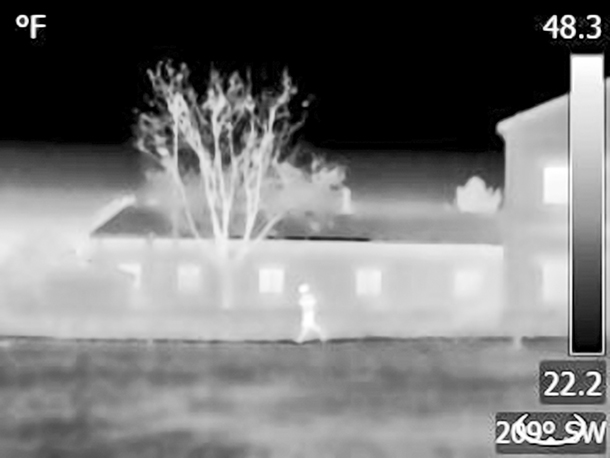One hundred and fifty years ago, after the realization of Manifest Destiny, livestock and the routes they were driven on were the lifeblood of a taming wild in the West, allowing enterprising pioneers and hard-boiled cowboys to fuel the burgeoning economy of a fresh and hungry America across unfriendly plains. They braved wild lands full of deadly, opportunistic predators; thieving scavenger animals; harsh conditions and unpredictable acts of violence from strangers with nothing but their wits and a Winchester.
The land has changed in the years between Charles Goodnight and Temple Grandin, just as ranching has. Innovation pushes the country forward, maintaining our edge and keeping America great. Out in Silicon Valley, they have Apple, Google and SpaceX pushing the envelope. Here in Texas, we rely on thermal imaging to bring us the latest technology and give us a leg up on what can be an unforgiving way of life.
Feral hogs are cuckoo for corn kernels
We’re talking about ranching, but anyone with any crops (and many without) can tell you the havoc feral hogs wreak on a fresh-planted field overnight. Hogs also pose a deadly (and costly) disease risk to cattle, not to mention what they can do to grazing land or fencing. Before the clever swine wised up, a fellow could grab a rifle, drop a couple and scare the rest off for the day.
Hogs are smart, though – and they’ve gone almost entirely nocturnal to protect themselves. In Texas, we’ve spun up a full and functional cadre of hog hunters who take to the field at night, ARs locked and loaded, to protect our nation’s food and fuel supply. They do a good job, but they aren’t stemming the tide. Hogs are still bleeding over $400 million out of Texas agriculture every year.
Enter thermal night vision. Take one of those hunters and give him a thermal rifle scope. Let him see in the dark. Give him the ability to spot a hog from 2,000 yards away. Give him the ability to take 30 or more precisely placed shots in rapid succession on a pitch-black night without endangering anyone or anything else. For a vigilant landowner, a thermal rifle scope can pay for itself in a single night; there’s also the bonus of filling up a freezer full of meat.
Calves are sitting snacks
Herds can need as much defending as a cornfield. Have you ever seen what a hungry coyote will do for some veal? Depending on where you hang your hat, you could be looking at mountain lion, bear or wolf predation (among many others) on cattle.
The good news is: In a city like Houston, you can pick up a thermal scope for about the price of a bred pair. The first seven or eight months of a calf’s life, it is vulnerable – usually carelessly hanging around its mother without the wits or weight to protect itself from anything. That’s why ranchers can choose to protect their investment with thermal. The first time someone gets a boiler-room shot on a ’yote that would’ve dragged off a walking investment, they know there’s no going back.
Cattle are as sharp as the leather they wear
Calving season is a stressful time. It means a lot of late nights, chains at the ready, and a lot of hands-on management of the only investment I know that seems, at times, hell-bent on finding new and creative ways to die. Since newborns don’t always have the good sense to stick with the herd, they sometimes require encouragement.
Similarly, a calf’s (or mother’s) refusal to stand, move or otherwise engage could be an early sign of trouble brewing. With thermal, you can find out what you need to know (Is he there? Is he moving? Is his mama nearby?) without even pulling your boots on. Full-grown and normally good-tempered heads will wander off from time to time. If you’ve ever spent hours combing a pasture for that one last heifer with an adventurous spirit, you already know the value thermal can bring.
One hand can cut the time spent searching exponentially just by using thermal; scan the pasture with a handheld thermal, and you’ll see (or not) in seconds the tell-tale glowing of a warm body, whether they’re back in the trees and brush, standing alone or covered up by darkness. A thermal monocular is also a handy tool to have around when trying to get a head count without running up and down the length of the whole fence; you can figure whether or not you need to go searching, right from the comfort of your porch, in any weather.
This land is my land
Cattle and coyotes aren’t the only ones going bump in the night. The cover of darkness presents unique challenges for ranchers and landowners of all types. Whether it’s illegal trespass, vandals, thieves or just drugged and drunk kids, there’s plenty of damage to be done to our land by our fellow man. Unlike cattle, people are not pushed back by barbed wire – they just hop it.

You can paint your posts purple or throw up whatever cutesy sign you like. It’s not going to stop somebody who wants to get on your land. Ranchers can use the same technology to catch criminals they normally employ to caretake cattle. Whether it’s to document with photo and video (some thermal imagers offer this as an option) or just to call the sheriff the moment you see trouble, thermals are key, again, in fighting back against the varmints and vermin (animal or otherwise) on your land. ![]()
PHOTO 1: Thermal sensors can allow a producer to observe how cows and their calves are moving from a distance. Thermal imaging photo by Cole Justice.
PHOTO 2: Getty Images.
Cole Justice is a marketing manager with Sellmark Corporation. Email Cole Justice.







